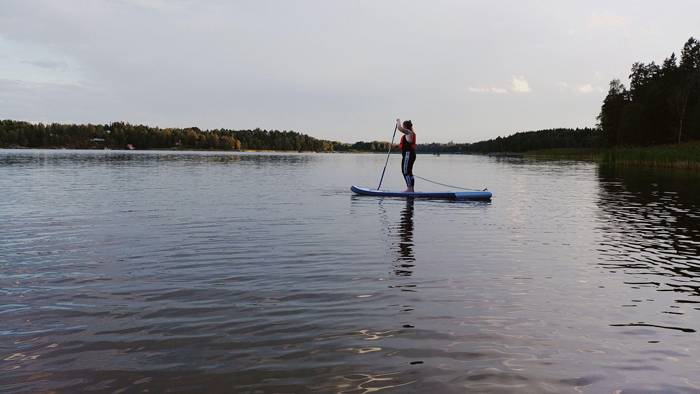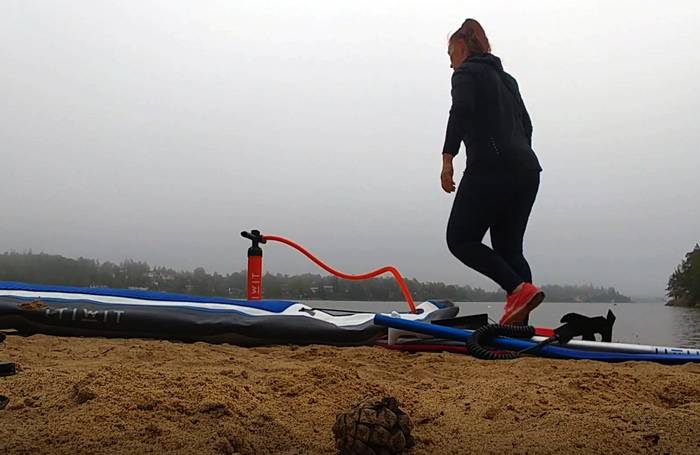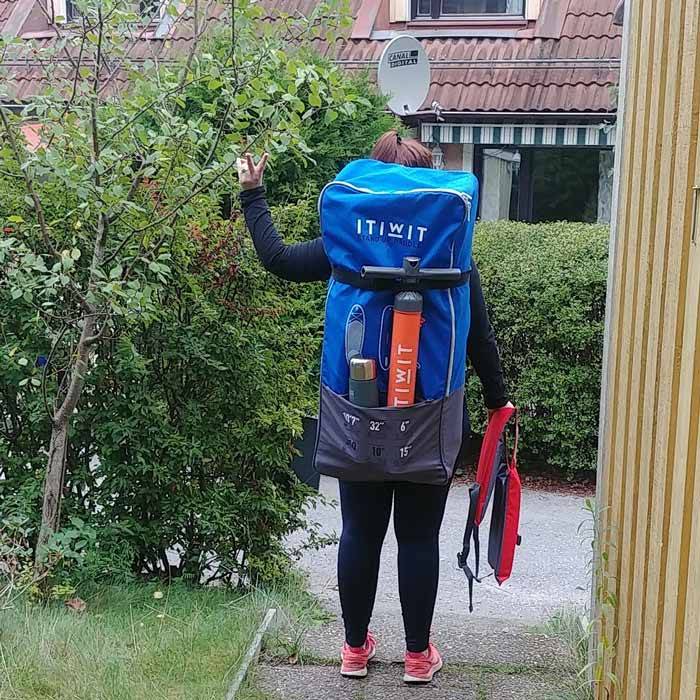Updated
Guide: How to get started with SUP (Stand Up Paddleboarding)
You've probably seen them too – images on social media of people gliding over the water on what looks like a surfboard. It’s difficult to not instantly wonder what they’re doing and how you can try it out. It’s called stand up paddle boarding, and it’s the quickest growing water sport in the world and in the UK and, best of all, it is easier than you think!

What is stand up paddleboarding (or SUP, as it’s also called)?
Stand up paddleboarding has taken the world by storm in recent years and originally comes from Hawaii. Watersports are constantly increasing in popularity, and if you find the step up onto a board to surf waves or wind is too big – and perhaps a bit intimidating – but you’d still like to try out watersports, paddleboarding may be the one for you. Even though what you most often see on Instagram are calm paddling trips on mirror-still lakes in the sunset, stand up paddleboarding can be considerably more lively than that. But as a beginner, those calmer sessions are most attractive, making it an easy sport to get started with.
Stand up paddleboarding is done on a board very similar to a surfboard, but a surfboard and a stand up paddleboard (or SUP as they're more often known) are less similar than you might first think. The most obvious difference is that a paddleboard is generally larger than a surfboard, both in length and width. The size increases stability during those sunset sessions. To move yourself forward on an SUP, you use a long paddle, which means you aren’t as dependent on wind and waves as you are with traditional surfing or windsurfing. But don’t be fooled – the weather is also important when you’re stand up paddleboarding.
How to start paddleboarding
It may be tempting to immediately order your own SUP board and get started, but trying it out before you invest in your own paddleboard is a good idea. There are paddleboard rental centres all around the country. And the big advantage is that you don’t even need to look for a coastal town, because you can also do stand up paddleboarding on lakes and rivers.
The majority of rental centres also organise introduction courses lasting a couple of hours, where you can learn the basics of stand up paddleboarding: standing up on the board, how to hold the paddle, the best way to stand on the board and how to get the most force from your paddle strokes. Of course, you can also work all this out on your own with a bit of help from YouTube, but the courses are a great way to get to know stand up paddleboarding and to feel confident in case you decide to hire a board for a session on your own.
If you decide to skip the introduction course and instead throw yourself in the deep end and learn by doing, stand up paddleboarding is a good sport for the impatient. If you’ve been able to borrow a board, hire one or even simply bought yourself one, the best thing to do is to find a lake on a day without a lot of wind where you can focus on learning the basics in peace, rather than having to fight against a headwind.
Two good inflatable SUP board to get you started

Waimea Stand Up Paddle Board Set
With this SUP board, you get all the accessories you need to quickly get started.
Which paddle should I choose?
Budget or premium paddle? There are paddles in all price classes, from the cheaper plastic versions to the featherlight carbon fibre paddles. For a beginner, an adjustable plastic paddle works very well – they are a little heavier than their more expensive carbon fibre siblings, but the price is much easier to cope with. The advantage of an adjustable paddle isn’t merely that more than one person can use it, regardless of how tall they are. It’s also much easier to take with you in the car, on the bus or even on your bicycle when you’re looking for the next watercourse to conquer with your SUP.
Best paddle length
How long the paddle should be depends on how tall the paddler is. A good guideline is that it should be 20 cm (~8') longer than your height. If you stand with the paddle upright next to you, you should just be able to reach up and get your palm and fingers fully over the top of the grip. If you’ve chosen an adjustable paddle, you can easily adjust the length, even if you’re out on the water.
Things to remember
You have to use the paddle for a stand up paddleboard in a specific direction. The blade is curved forward, which means that when the paddle is placed into the water, the curve should be facing away from you. A common rookie mistake is to hold the paddle angled towards you, which feels more natural, but you’ll soon discover that paddling is more difficult and awkward if you’re holding the paddle the wrong way round. Try it out – and feel the difference!

How to use a paddleboard – 6 easy steps
1. Launch the SUP board
Place the board in the water at a point where you can wade out with it a little way. Make sure the fin on the paddleboard is in deep enough water that it won’t scrape the bottom and get damaged when you stand on the board.
2. Get onto the board
Place one knee on the board, followed by the other, so you’re kneeling on it. To get a feeling for the board and the paddle, stay on your knees and paddle around for a bit. When you feel ready, it’s time to stand up.
3. Stand up – one foot at a time
Make sure you’re in the centre of the board and put your paddle down (there are straps on paddle boards that you can slide your paddle under while you stand up so it doesn’t fall into the water). Transfer your weight to one foot, while maintaining your balance with your hands on the board. Pick up the paddle again while you’re still on your haunches, move slowly to keep your balance and rise up to a standing position.
4. Stand correctly
Your feet should be about shoulder width apart and your knees soft – in other words slightly bent. If you feel a little wobbly, remember to activate your stomach muscles (suck your navel in towards your spine) – your core is the key to being stable on the board.
5. Start to paddle
Now it’s time to start paddling again. To start with, you’ll undoubtedly paddle slowly. Two or three strokes per side is generally enough before it’s time to change. If you don’t change side with your paddle regularly, you’ll quickly realise that the SUP board will gradually turn in a circle – and this is actually how you turn when you want to; by paddling on the side you want to turn towards.
6. Refine your technique
When you’re paddling, it’s a good idea to think about how cross-country skiers use their ski poles. Insert the paddle into the water far ahead of you, and press the top hand forwards while pulling the lower hand backwards. When the paddle is level with your feet, remove it from the water – if you continue the stroke past your feet you’ll slow yourself down.

Which SUP board should I buy? – 5 questions to ask yourself
There are a few basic questions you ought to answer before you start shopping for your very own SUP board.
1. How will I use the board?
The first question you should ask yourself is “How do I want to use it?” Stand up paddleboarding can be much more than meditative paddling on calm lakes. It can also be a sport where speed is the aim. You can also surf waves with your paddleboard, with your sights set on a trip to Hawaii. But as a beginner, it’s the calmer waters that make it easy to learn as a hobby, and that means you really need to look for an all-round board.
An all-round board is, exactly as you’d expect, a paddleboard that works for trying out different aspects of the sport. All-round boards are broad and stable, making them perfect for beginners.

2. Solid or inflatable paddleboard?
You also need to decide whether you want a solid board or an inflatable one (what’s known as an iSUP – inflatable stand up paddleboard). The inflatable boards are the most popular with beginners for several reasons. An iSUP is generally cheaper than a solid board. It’s also easier to store and transport, and that leads us to the third thing you should think about.

3. How much space do I have at home and how will I transport the board?
A solid SUP board takes up a lot of space in the home – most boards are around 3 metres (9,8+ feet) long, or longer - which requires a lot of space for the board to be stored safely. A board this size is difficult to tuck under your arm and carry to the water, unless you happen to live right by the sea. You also won’t be popular with bus drivers if you try to take one aboard – in other words, a car is pretty much essential when transporting a solid SUP board.
This is the beauty of inflatable boards, as they can be folded up in the bag they usually come with, when you buy one, and thus easily stored. This means that you can actually take your board with you on a bus or train journey, or pop it in your backpack to carry to the water.
An inflatable SUP takes about 5-10 minutes to fill with air, which you do using a pump. The pumps measure the air pressure in the board, so you can easily see when you’ve reached the correct pressure in psi and the board is ready for use. Of course, inflating the board can be a sweaty job, particularly when it’s a hot day, but you can see this as a warmup exercise.
When you've finished using the board, you let the air out by releasing the valve. While the board deflates, you can have a cup of coffee or dry the board (or both). Then you fold it up and stuff it back in the bag for the next time.
4. What size paddleboard should I buy?
The paddleboard size you need depends on how much you weigh. The bigger the board is, the more stable it will feel. If you buy a board that’s too small, it will be wobblier than if it’s a bit too big. Most sellers have size tables so you can find the perfect size, but this is also a good reason to hire a board first, as this means you can get a professional to help you find just the right size.
5. How much do I want to spend?
The cheapest paddle boards cost around £300, and the most expensive ones can cost almost anything. The type of board you choose will also affect the price, and also whether you choose to buy a new one or look for a second-hand one. Regardless of the type of board you choose, make sure you compare prices – they can vary quite a lot. Also, don’t forget to read reviews. There are articles and videos with extensive reviews of most SUP boards.

Ten quick tips for SUP board buyers
- Hire first, buy later.
- Always use a safety line – what’s known as a leash. If you fall off – which you will – even a light wind can make it difficult to catch up with your board. But with your leash attached, you’ll always have your board within an arm’s length.
- Don’t forget your life vest. Particularly not if you’re paddling on your own.
- Don’t be scared of falling off. Practice controlled falling a few times, then you can get used to hauling yourself out again. It’s not difficult. It’s fun!
- Use your paddle the right way round: with the blade angled forwards and away from you.
- Look for a second-hand SUP board online.
- If you don’t want cold feet, you can buy neoprene paddling shoes or socks.
- You can do stand up paddling in most types of clothes, but if you want to extend the season when the water’s colder, it’s best to kit yourself out with a good wetsuit.
- Try to get the paddle into the water as far from you as possible and pull it towards you with your lower arm against your body. Stop the stroke when the paddle is level with your feet.
- Take your child with you, sitting on the board. It’s a wonderful experience for both of you. But once again, don’t forget your life vests.
Must have-accessories for the stand-up paddler

Never without a life jacket
A life jacket really shouldn't be optional. Yes, you might be a great swimmer, but unexpected things do happen when water sporting. Stay safe - wear a life jacket. And if your kids go paddling with you, they have to wear life jackets as well.

A good SUP-pump
A dual or triple action pump will make pumping the SUP a little bit less sweaty (it will still be sweaty for sure, consider it your warmup).

SUP goes kayak
Want to turn your SUP into a (really flat) kayak? Stick one of these kayak seats on to it, and buy a kayak paddle. Great when you want to give your legs a bit of a rest.